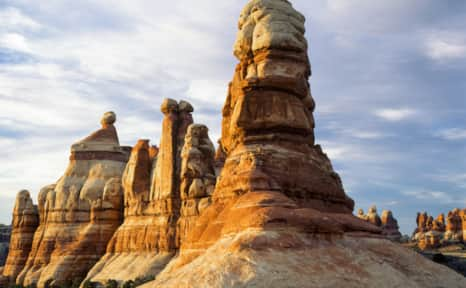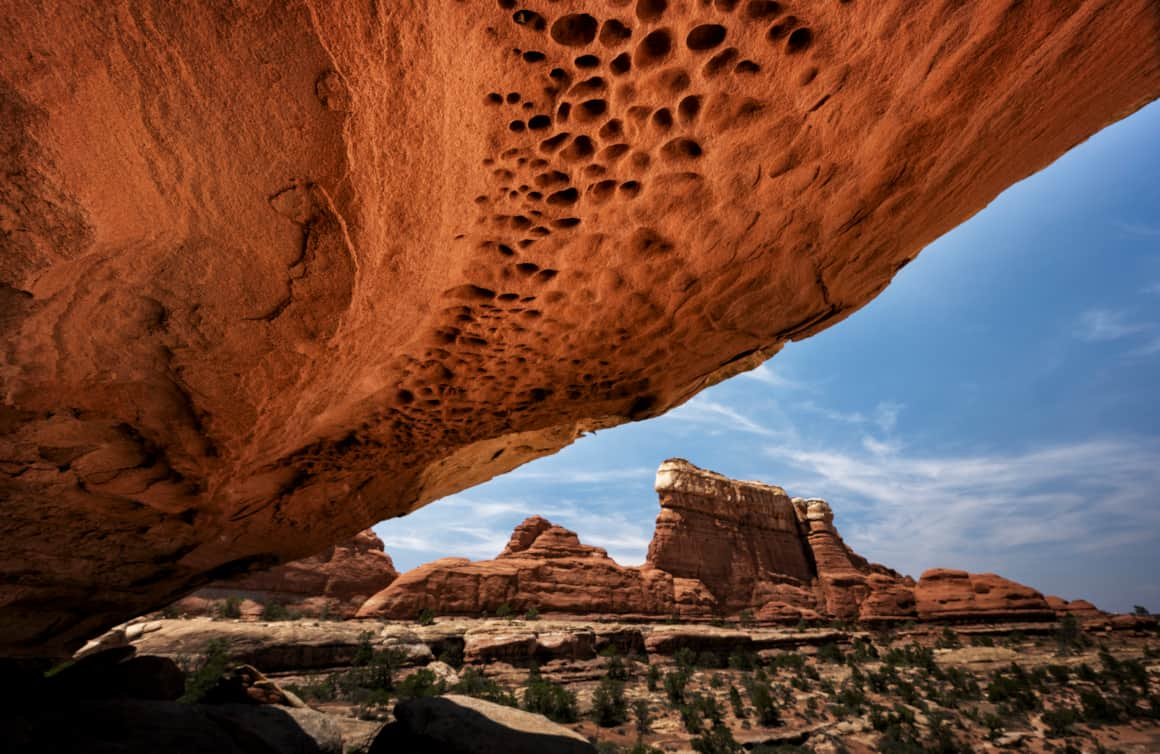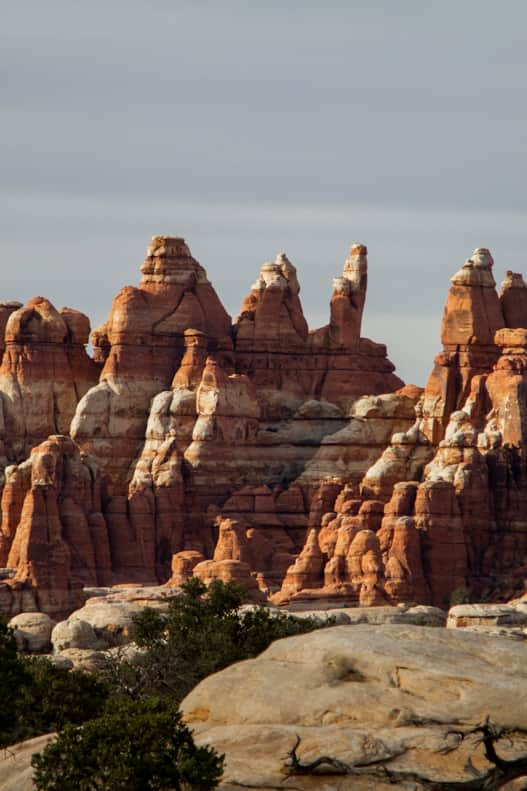Getting to Canyonlands National Park
Canyonlands National Park is located in east-central Utah, southwest of Moab. Commercial airlines serve Grand Junction, Colorado, and Salt Lake City, Utah. By car, these cities are at least 2 and 4 hours (respectively) away from the closest park entrance (Island in the Sky). Commercial air service is also available between Denver and Moab.
Canyonland National Park contains three districts — Island in the Sky (most popular), Needles and Maze (most remote). Each district of Canyonlands must be visited separately; no bridges or roads connect the districts within the park. The visitor centers are a great place to find Canyonlands travel tips, maps and more, but note that operation hours of all three district visitor centers changes with the seasons.
Island in the Sky Visitor Center
Island in the Sky Visitor Center is open daily from spring through fall from 9 a.m. to 4 p.m., with longer hours during the summer. It is closed in the winter. Backcountry permits are issued up until one hour before closing. The visitor center is closed Thanksgiving Day, Christmas Day, and from late December through February.
To get to Island in the Sky from Moab, drive north on U.S. 191 10 miles to S.R. 313. To reach the same point from farther north, drive 22 miles south from I-70. Once on SR 313 drive southwest 25 miles to the Island in the Sky entrance station.
Needles Visitor Center
Needles Visitor Center is open daily spring through fall from at least 8:30 a.m. to 4 p.m. It is closed in the winter. The visitor center closes on Thanksgiving Day and from early December through February.To get to the Needles District from Moab take U.S. 191 south for 40 miles and turn right (west) onto S.R. 211. Follow this paved road 35 miles to the Needles District entrance station. Be careful not to take Needles Overlook Road, which takes off a few miles before the correct junction. This road does not take you to Canyonlands National Park. Watch for the Canyonlands National Park sign before turning. From Monticello drive 14 miles north on U.S. 191 and turn left (west) onto S.R. 211.
Maze District: Hans Flats Ranger Station
Only unpaved roads access the Maze. The Hans Flat Ranger Station is open from 8 a.m. to 2 p.m. and is located 2 1/2 hours from Green River, Utah. From I-70, take Utah Highway 24 south for 24 miles. A left-hand turn just beyond the turnoff to Goblin Valley State Park will take you along a two-wheel-drive dirt road 46 miles (76 km) southeast to the ranger station.
There are two additional areas in Canyonlands National Park: the Horseshoe Canyon Unit, which is a detached section northwest of the Maze and features prehistoric pictographs in the Great Gallery; and the River District, which includes stretches of the Green River and Colorado River.
GPS Coordinates of Park Entrances
Island in the Sky entrance: 38.473405, -109.809587. Needles Visitor Center: 38.168509, -109.753276. Horseshoe Canyon Unit (no entrance station; road not paved): 38.473935, -110.200285.

The Needles district of Canyonlands National Park

Canyonland National Park contains three districts — Island in the Sky (most popular), Needles and Maze (most remote).
Geography and Geology
Canyonlands National Park is a unique outdoor museum of natural history and geology. It is a landscape dominated by rock. Here erosion has sculpted, sliced, and shaped the bedrock into cliffs, pinnacles, flying buttresses, minarets, abrupt canyons, and rounded domes. The horizontal strata of sedimentary rocks, stacked like layers on a wedding cake, yields a lesson in geological history. Each rock layer seen here — Navajo sandstone, Kayenta Formation, Wingate sandstone, the Chinle and Moenkopi Formations, White Rim sandstone, and Cutler Formation — tells a tale of the earth’s varied history.
The cliff-forming Navajo and Wingate sandstones were deposited as immense sand dunes that blanketed most of Utah during the Mesozoic Era. During moister times, earlier formations were laid down as sand, silt, and mud on floodplains and broad river deltas.
Do Your Research
-
Check the Weather
Be sure to read the weather forecast and understand how the climate and conditions will impact your day’s outing and be aware of your own limits. Pack accordingly and be sure to bring enough water, food, proper clothing and sun protection.
-
Get the Latest Information
Check the current regulations and suggested guidelines for the places you intend to visit. For the latest information, visitors may follow Canyonlands National Park on Twitter and Facebook or check nps.gov for the latest park alerts and conditions.
-
Make a Plan
Create a trip plan and make sure someone knows where you are going and when you will return. Don’t expect cell phone service to work, having a printed map is always helpful. Be aware of potential hazards, including wildlife, lightning, flash floods and extreme heat. Assess your abilities, goals and skills and make sure your planned activities are a good match. Reach out to a park ranger if you’re unsure.
Visit With Respect
The red rock desert is a fragile ecosystem, and visitors should take special care to protect it. Practice Leave No Trace principles to ensure that all parts of the park are left as nature intended.
Pack out everything you bring with you, including food wrappers, tissues and even crumbs. Canyonlands requires visitors to pack out solid human waste, toilet paper and hygiene items. (Read: How to Poop in the Outdoors)
Stay on existing trails and do not travel off course or “bust the crust.” A single footstep can cause damage that lasts for decades. Rock cairns, or rock piles, are trail markers. Do not disturb them or add new ones, as they could mislead other hikers.
Treat the arches and other geologic features with respect, both to protect them and yourself. Walking, climbing and scrambling on arches — even for a quick photo — is not permitted.
Leave rocks, plants, animals and natural objects as you found them. Never leave marks or scratches on rocks or other surfaces and admire artifacts and natural features from a distance without touching or disturbing. Tree carvings, rock etchings and spray painting are forms of vandalism and graffiti, which are illegal on public lands.
Respect the wildlife that make Canyonlands National Park their home. Keep your distance, and if an animal changes its behavior due to your presence, you are too close. Secure your food so animals cannot access it, and never feed wildlife.
Camp only in designated areas on durable surfaces and follow all campfire rules and regulations.
Leave drones and pets at home. The use of off-highway vehicles (ATVs, OHV, UTVs, etc.) is also not allowed in Canyonlands National Park.
Be courteous to other visitors by minimizing noise, yielding to others on trails and respecting trail and transportation signage.
Show consideration for other visitors, and be a mindful photographer. Canyonlands is an internationally certified Dark Sky Park, making it a prime location for night photography or stargazing. Do note that using artificial light sources to illuminate park features for photography is not permitted.

When traveling with a group in the outdoors, it's important to understand the limitations of each individual in your party.
Photo: Rosie Serago
How to Take Care of Yourself in the Desert
You can’t enjoy the splendor of Canyonlands sufficiently and preserve this treasured place if you’re not first taking care of yourself and those in your group. Watch where you step, know your physical limits and pack all your essentials, from first aid or medical supplies to proper clothing and enough water and food.
Prepare for the Heat
During the hottest parts of the day in the peak of summer, temperatures can spike over 100°F. Avoid exertion or overheating during the peak temperatures of the day. Consider hiking in the cool of the mornings and evenings. There is very little shade on most trails within the park. Protect yourself with sunscreen, sunglasses, a hat and protective clothing.
Stay Hydrated
Dehydration is a real threat in desert environments. Active hikers should bring at least one gallon of water per person daily. Remember to stay hydrated by drinking water before you get thirsty. Always carry enough water to meet your daily needs or research ahead where drinking water may be available. Desert water sources may run dry at certain times of the year and, if untreated, can contain harmful or toxic microbes that can impact human and pet health.
Pack Enough Food
Bring enough food and snacks for your group and for the outing you have planned and be aware of where food is served within or outside the park. Remember to pack out what you brought in and dispose of all trash properly.

